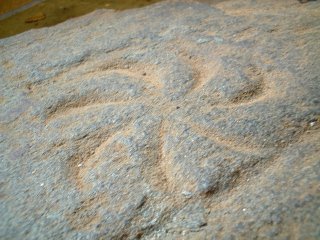
Talking of stories in stone, as we were a couple of postings back, I saw a fascinating old stone on the Isle of Gigha when I visited the island in the spring. Some of the older cottages in the north of the island were being renovated when a strange archaeological discovery was made: a large stone, which was being used as a lintel over an old fireplace. When the workmen carefully extracted it, they realised that they were looking at a whole section of island history encapsulated in stone. The lost language of these carved stones always fascinates me. It is as though we have lost the key to it - or to most of it. Previous inhabitants of the Scottish islands may have understood these symbols much more clearly than we do, but the enigmatic quality of these things still fascinates us.
The large slab of stone was literally covered in carvings which seemed to date from many different periods. There was an ancient 'cup' mark, thought to date from Stone Age times, as well as a traditional sun symbol (shown above) There was an obviously Christian cruciform shape; early Celtic saints would often 'christianise' pagan stones by adding appropriate holy symbols, presumably as part of some ceremony of blessing , without defacing the earlier inscriptions.
There were also the faint remains of what may have been a hunting scene (possibly Mediaeval) and another strange outline which looked like nothing so much as a stylised whale. And then there was much later lettering, perhaps added by those who had incorporated this stone into their house - possibly because they recognised its age and sanctity, and thought that it might bring luck to hearth and home. Gazing at this mysterious survival of an ancient, symbolic language, I wondered just how many other magical stones may have been removed from old buildings and carelessly demolished over the years.
1 comment:
I was wondering if you have any other photos of the stone, I am very interested..
Post a Comment